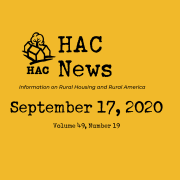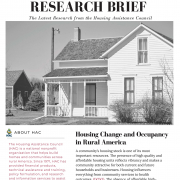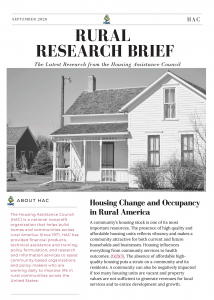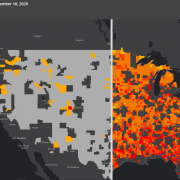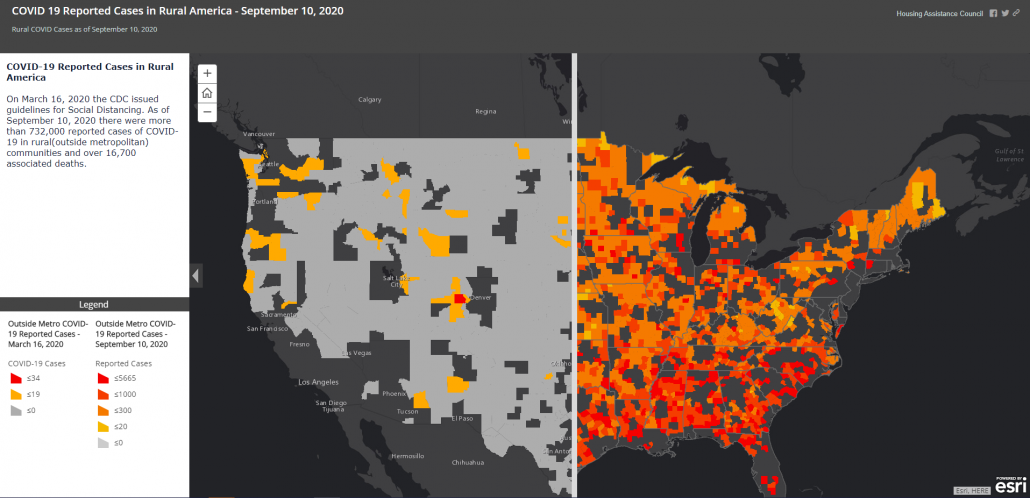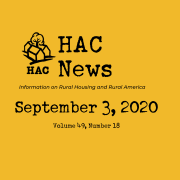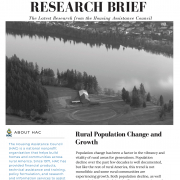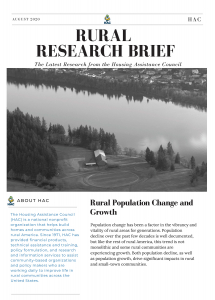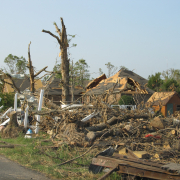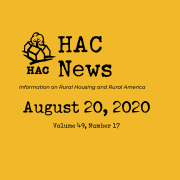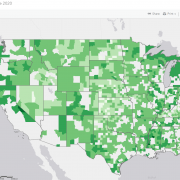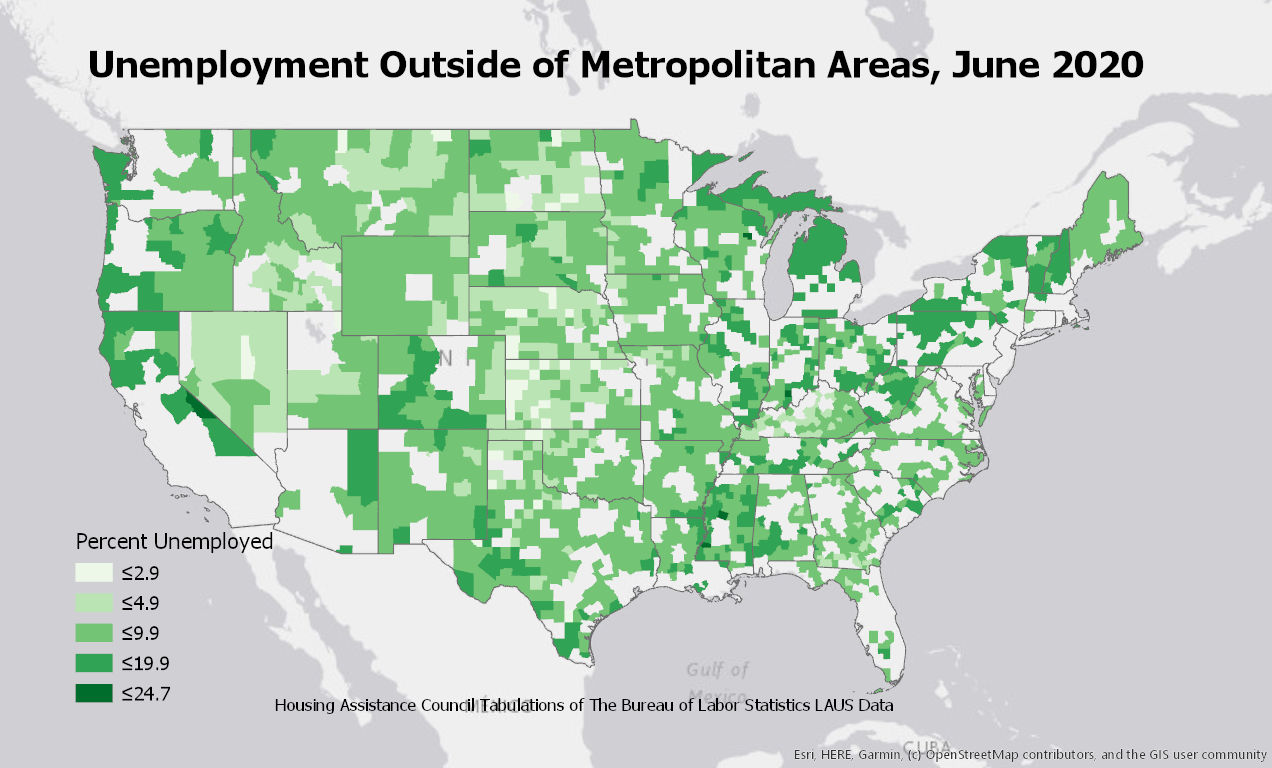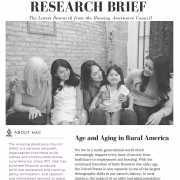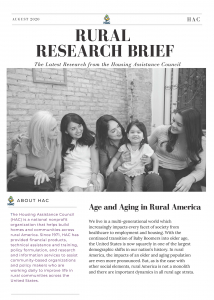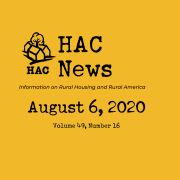HAC News: September 17, 2020
HAC News Formats. pdf
September 17, 2020
Vol. 49, No. 19
TOP STORIES
Continuing resolution will not include economic relief.
Congress and the White House are negotiating details of a continuing resolution to fund the government when fiscal year 2021 begins on October 1, but reportedly have decided the measure will not include additional funding to address the economic impacts of the pandemic. Separate negotiations on a new relief package have not resulted in an agreement; on September 10 the Senate voted down the most recent proposal, a “skinny” bill introduced by Senator Mitch McConnell (R-KY), which would not have provided any housing aid.
Online session to cover rural housing challenges in pandemic.
Shelter in Rural Places: Facing Rural Housing Challenges in the Unfolding Pandemic, to be held on September 22, will be the third Rural Opportunity and Development (ROAD) session. Rural and tribal organizations will share their analysis and useful strategies for helping rural residents, workers and families address housing distress and homelessness, including strategies that could help fend off further crisis if federal and state unemployment and housing assistance run dry. The ROAD sessions virtual exchanges are co-designed and hosted by the Aspen Institute Community Strategies Group, the Housing Assistance Council, the Rural Community Assistance Partnership and Rural LISC.
HUD posts final disparate impact rule.
HUD has posted online the final version of its revised disparate impact rule, though the department has not issued an announcement or statement about it and it has not yet been published in the Federal Register. The final rule is not identical to the proposed regulation released in August 2019, but retains the proposal’s heavy burden of proof for an injured party.
Public charge rule now active nationwide.
In July a federal court issued an injunction halting implementation of the new public charge rule, which establishes limits on immigrants’ use of public assistance. In August an appeals court narrowed the injunction so it applied in only three states. On September 11 the appeals court stayed the injunction nationwide so that, while proceedings on the lawsuit continue, the Department of Homeland Security can enforce the rule throughout the United States. More information about the rule is available from the Protecting Immigrant Families Campaign.
HAC posts disaster guide for West Coast wildfires.
The guide provides resources for people affected by the recent fires in California, Oregon and Washington.
September 15-October 15 is Hispanic Heritage Month.
RuralSTAT
79% of rural homes are occupied. Nearly half the unoccupied units are vacation homes.
Source: HAC tabulations of 2014-2018 American Community Survey Data. For more information on housing change and occupancy in rural America, visit HAC’s newest Rural Research Brief.
OPPORTUNITIES
HUD offers funds for healthy homes and reduction of health hazards.
State, local and tribal governments, nonprofits, for-profits, public housing authorities and others can apply by November 9 for Healthy Homes and Weatherization Cooperation Demonstration grants to coordinate healthy homes and weatherization programs. For more information, contact Brenda M. Reyes, HUD. Public housing agencies are the only eligible applicants for the Lead-Based Paint Capital Fund Program, which will fund evaluation and reduction of lead-based paint hazards and other housing-related hazards including carbon monoxide and mold in public housing. The deadline is November 2. For more information, contact HUD staff.
October deadline approaching for stimulus check applications.
October 15 is the deadline for people to apply for the $1,200 stimulus payments authorized by the CARES Act earlier this year if they are eligible but did not receive funds automatically or request them. Anyone who misses this deadline will have to file a tax return for 2020 to claim the payment. Details are available from the IRS and from the Center on Budget and Policy Priorities. CBPP also offers outreach resources for informing eligible people about the deadline. Assistance for individuals is also available online or through United Way’s helpline,1-844-322-3639.
POLICY
Emergency rental relief is overdue.
HAC joined six other leading affordable housing organizations in a statement issued September 16 calling for immediate rental assistance, paired with financial support for affordable housing providers, to supplement the protection provided by the CDC’s recent eviction moratorium. While some property owners have resources to help them weather the temporary loss of rental income, many providers of affordable housing do not.
CORONAVIRUS
HAC finds rural share of COVID-19 cases still rising nationally.
As of September 10, all but 14 counties outside of metropolitan areas have reported COVID-19 cases, and nearly three-quarters of outside metro counties have also reported associated deaths related to the virus. HAC’s latest update on the pandemic’s rural impact is available online.
USDA updates its pandemic information.
USDA Rural Development has posted an updated version of its summary about actions taken in all its programs, a bulletin on servicing relief for homeowners with Section 502 guaranteed mortgages in disaster areas, revised FAQs for lenders using the Section 502 single-family guarantee program, and an announcement about the CDC eviction moratorium. For more information, contact an RD service center.
“Strained rural water utilities buckle under pandemic pressure.”
The Pew Charitable Trusts look at how the pandemic has reduced the revenue stream for many rural water systems which were already strained. While some rural systems received funding from the Paycheck Protection Program, these utilities generally have not benefitted from federal or state pandemic relief programs.
REGULATIONS AND FEDERAL AGENCIES
USDA issues final rule on broadband infrastructure funding.
The final rule for broadband infrastructure allows awardees under select RD programs to use a portion of their funds to help expand access to broadband services for America’s rural businesses and residents. Eligible programs include Section 515 direct and Section 538 guaranteed rental housing loans. USDA requests comments by November 16 on this regulation. For more information, contact Michele Brooks, USDA, 202-690-1078.
PUBLICATIONS AND MEDIA
Growth or decline in housing units and vacancy rates vary across rural America, HAC reports.
Housing Change and Occupancy in Rural America, a new Rural Research Brief, considers some of the factors contributing to, and resulting from, change in the rural housing stock.
Supportive housing resources posted online.
Materials and a recording from HAC’s Introduction to Supportive Housing webinar are now available online. This session, the first in a three-part series, provided a comprehensive overview of permanent supportive housing, explained the guiding principles of the Housing First approach, outlined supportive services, and presented the trauma-informed care and design framework. Part II will be held on October 15 and Part III on November 17. When registration opens, information will be posted on HAC’s website.
“For BIPOC communities, local news crisis extends beyond major cities.”
This article in the Columbia Journalism Review describes the “need for journalism’s reckoning regarding racial justice to extend beyond major cities to issues faced by [Black, Indigenous and people of color communities in small towns and suburbs.”
“Dead chicks, delayed prescriptions: Late mail leaves rural America disconnected.”
NBC News describes some of the many ways postal service is critical to connect rural communities with the rest of the nation. Many rural communities depend on their mail careers for essentials ranging from prescription medicines to paying bills.
HAC
Need capital for your affordable housing project?
HAC’s loan funds provide low interest rate loans to support single- and multifamily affordable housing projects for low-income rural residents throughout the U.S. and territories. Capital is available for all types of affordable and mixed-income housing projects, including preservation, farmworker, senior and veteran housing. HAC loan funds can be used for pre-development, site acquisition, site development and construction/rehabilitation. Contact HAC’s loan fund staff at hacloanfund@ruralhome.org, 202-842-8600.
Please note: HAC is not able to offer loans to individuals or families. Borrowers must be nonprofit or for-profit organizations or government entities (including tribes).

